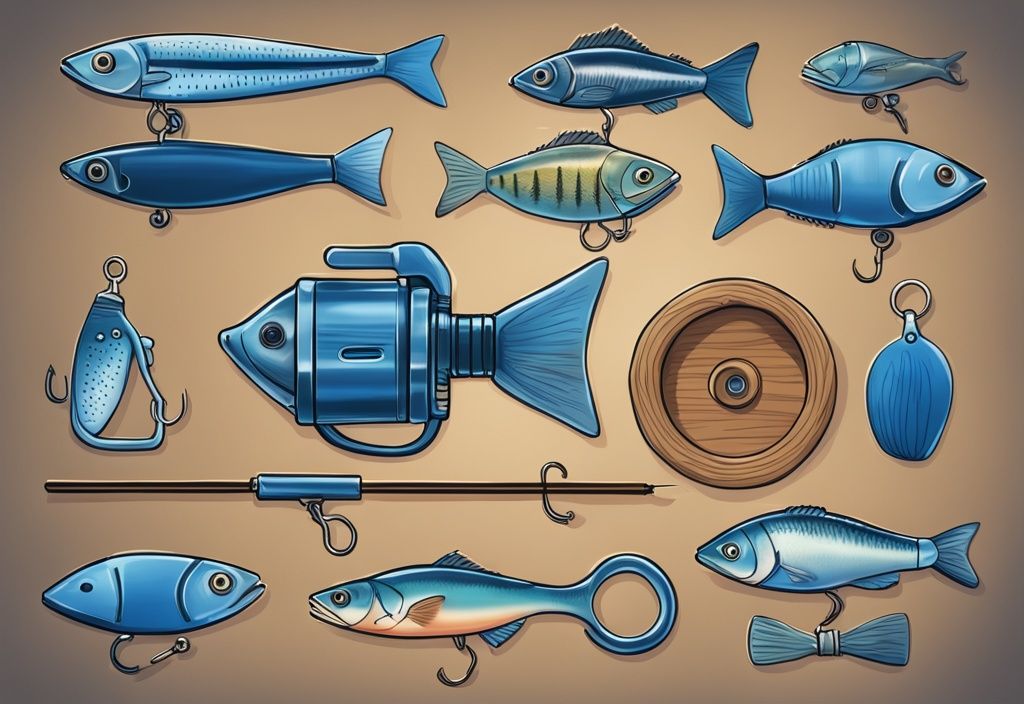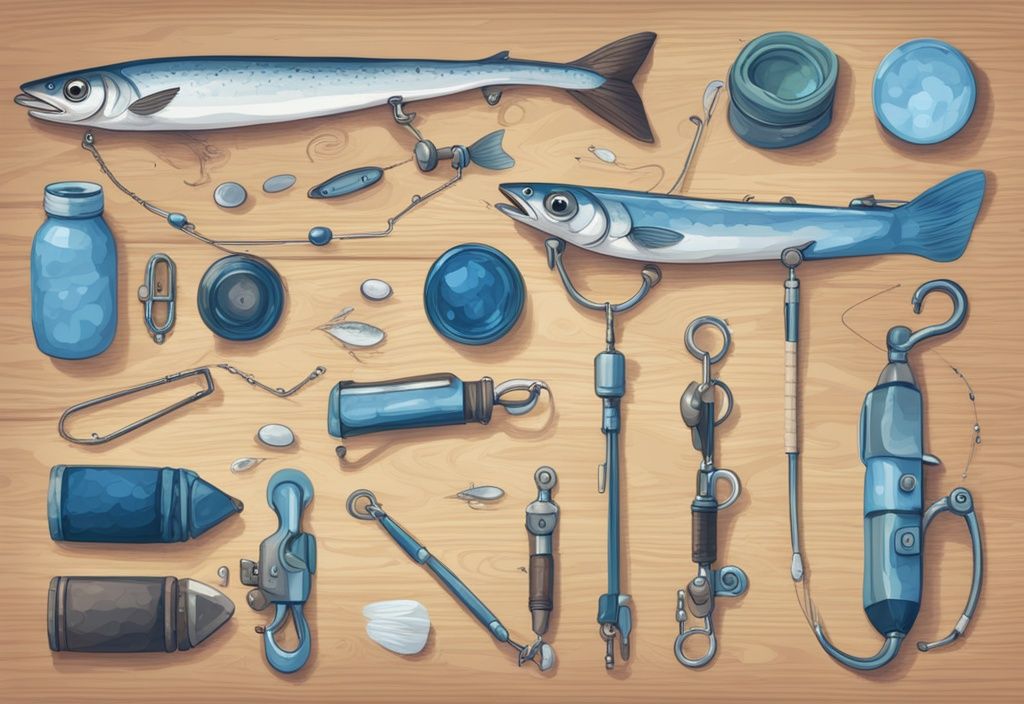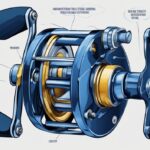Ever battled with a twisted line when what’s on the other end is a potential whopper? Nothing dents a fishing trip quicker, right? Enter fishing swivels, those pocket-sized lifesavers that every angler worth their salt carries. But what are fishing swivels?
Fishing swivels are truly game-changing, preventing your line from twisting, saving you precious time, and not to mention, your sanity on a tough day. In this article, we’ll be pulling back the curtain on these useful little devices, delving into their types, unique applications, and how they can drastically enhance your fishing exploits.
So whether you’re a greenhorn looking to learn the ropes or an old hand aiming to up your game, sit tight and prepare to discover how picking the right swivel could make the difference between a great angling experience and an unforgettable one.
A Simple Introduction to Fishing Swivels
Fishing swivels, those tiny yet mighty tools, are staples in any angler’s tackle box. These nifty gadgets keep your fishing lines straight and tangle-free, no matter how many times you cast or reel in. Imagine casting your line without a care in the world, knowing that these ball- or barrel-shaped marvels have your back. A swivel’s construction is pretty clever, with a proximal ring connecting to your rod and reel line, and a distal ring ready to hook up with your terminal tackles—think hooks and lures. It’s all about smooth, stress-free fishing.
One of the greatest perks of using fishing swivels is their ability to prevent those annoying line twists and tangles that can mess up your day. They’ll help you cast further and retrieve more efficiently. Plus, they’re made from robust materials like stainless steel or brass, ensuring they can withstand the test of time and the elements. Available in different sizes and colors, even sleek anodized black, you can pick the perfect swivel for your needs.
What is a Fishing Swivel and Its Importance
A fishing swivel might look simple, but it’s a game-changer. It comprises two rings linked by a thrust bearing pivot joint, allowing each section of the fishing line to rotate independently. This clever design tackles one of the peskiest problems in fishing: line twists. If you’ve ever dealt with monofilament lines coiling up on you, you’ll know exactly what I mean. To learn more about avoiding line twist, especially when using spinning tackle, check out this helpful guide on how to avoid line twist with spinning tackle.
Swivels boost your casting performance and reduce the chances of your line tangling. They’re particularly useful with lures that twist lines, like inline spinners and metal spoons. Incorporating swivels into your setup not only optimizes lure performance but can also increase your catch rate. For any angler, from novice to pro, understanding and using swivels is a crucial step toward a more successful fishing adventure.
Exploring Different Types of Fishing Swivels
When it comes to understanding “what are fishing swivels,” it’s essential to grasp that they’re tailored for various techniques and conditions. These nifty little tools can make a world of difference in your angling experience, and each type brings something unique to the table.
Varied Fishing Swivels and Their Unique Uses
Choosing the right fishing swivel can be the game-changer in your tackle box. Let’s break down some common types and their specific uses:
- Barrel Swivels: If you’re fishing in scenarios where lures or rigs aren’t spinning endlessly, barrel swivels are your go-to. They offer basic, reliable anti-twist functionality. Easy to use and dependable, they are a staple for many anglers.
- Ball-Bearing Swivels: These are top-notch for high-performance needs, especially with lures known to spin a lot—think inline spinners and metal spoons. The ball-bearings ensure smooth rotations and help minimize those pesky line twists, making your casts smoother and more effective.
- Snap Swivels: For those moments when you need to swap lures in a flash, snap swivels are a lifesaver. Combining a swivel and a snap hook, they offer quick changes without worrying about line twists. Their dual functionality saves you time and keeps you in the game longer.
- Three-Way Swivels: These swivels come with an extra ring, making them perfect for more complex setups like dropper rigs or when you need side-branching line segments. They bring a lot of versatility and flexibility, especially handy in multi-hook or multi-bait fishing scenarios.
- Crane Swivels: Offering a balance between barrel and ball-bearing swivels, crane swivels provide good rotation efficiency. They’re a versatile choice, fitting into a wide range of fishing styles and conditions.

Choosing the Right Fishing Swivel for Your Angling Needs
Finding the perfect fishing swivel goes beyond just picking one off the shelf. It’s all about understanding your angling needs and how different swivels can enhance your fishing experience. Let’s dive into the nuances of choosing the right swivel, considering factors like size, strength, and specific fishing applications.
Key Factors to Consider
When pondering the question, “what are fishing swivels” meant for your unique fishing style, the first step is to assess your fishing technique and the type of lures in your tackle box. Different fishing methods and lures exert varying levels of line twist, and that twist dictates the type of swivel you’ll need. For example, when using inline spinners, you’ll require a ball-bearing swivel that can handle the significant rotation.
Durability is another paramount consideration. Opt for swivels crafted from robust materials like stainless steel or brass. These materials are not only resilient but also resistant to corrosion, ensuring your swivel remains in peak condition across numerous fishing adventures.
Don’t overlook the color of your swivel. Traditional anodized black swivels are favored for their ability to minimize underwater visibility, thus reducing the likelihood of spooking fish. However, some modern hues, such as red or blue, might attract specific fish species or blend better in particular waters. Choose a color that aligns with the environment you’re fishing in and the behavior of your target catch.
Size and Strength: Understanding the Aught Scale and Pound Test Ratings
Swivel size is typically identified using the aught scale, which spans from size 12 (the smallest) to size 12/0 (the largest). The swivel’s size impacts both its visibility to fish and its overall strength. Picking the right size is essential; smaller swivels are less detectable by fish but might lack strength, while larger swivels are stronger but more conspicuous.
Equally important is the pound test rating of the swivel. This rating indicates the maximum weight the swivel can handle without breaking. Align the pound test rating with the weight of your targeted fish to ensure reliability. For instance, if you’re pursuing large, aggressively fighting fish, opt for swivels with higher pound test ratings to withstand the intense battles.
Mastering the balance between size and strength will significantly enhance your fishing endeavors. Ensuring your swivel can endure the challenges and demands of your fishing trips will not only boost your confidence but also make your fishing experiences more enjoyable and success-filled.
The Advantages of Using Fishing Swivels
Fishing swivels offer a multitude of benefits, making them essential in various angler setups.
Notable Benefits and Practical Applications
Understanding what are fishing swivels opens up a world of advantages, enhancing efficiency and success on the water. One of the most notable benefits is their ability to prevent line twists. Imagine casting out your line and retrieving it without the dreaded tangles. Swivels, by allowing the line to spin freely, keep the integrity of your line intact, cutting down frustration and saving valuable fishing time.
Fishing swivels also significantly improve casting performance. With swivels in place, you’ll notice smoother casts and pinpoint accuracy. The connection between your mainline and rig flows seamlessly, reducing drag and resistance. It’s like your line becomes an extension of your arm, offering better control and longer casts.

Another standout benefit is the ease of changing lures. Snap swivels, in particular, make swapping out lures a breeze. You’ll appreciate this feature when experimenting with different lure types and colors to see what piques the interest of the fish. No more tedious knot-tying, just quick, efficient changes as you adapt to the conditions.
Beyond these primary benefits, fishing swivels offer versatility in rigging. They can act as stoppers for sliding sinkers, allowing for customizable and adaptable setups. Whether you’re sea fishing, freshwater fishing, or even fly fishing, having the right swivel ensures your gear performs optimally. Each environment presents unique challenges, and swivels add that needed flexibility to tackle them.
Incorporating fishing swivels into your gear transforms your angling experience. By truly understanding what are fishing swivels and their practical uses, anglers of all skill levels can enjoy smoother operations, enhanced performance, and more enjoyable fishing trips. So, the next time you’re out there, under the sun with the sound of water lapping, remember those little swivels and the big difference they make.
Commonly Raised Concerns about Fishing Swivels
Fishing swivels are invaluable tools for many anglers, yet they come with their own set of potential pitfalls. These concerns, which often surface in discussions on what are fishing swivels, can impact your fishing experience if not properly addressed.
Potential Downsides Explained
- Fishing swivels can reduce the effectiveness of certain lures that perform better without additional hardware.
- They may serve as weak points on the line, particularly if mismatched in strength or size, decreasing the likelihood of landing larger or aggressive fish.
- Improper usage or poor-quality swivels might still result in line twists or tangles.
Swivels are like the unsung heroes of fishing gear, but even heroes have their Achilles’ heel. When you’re figuring out what are fishing swivels and how they fit into your setup, it’s key to consider a few potential downsides. Imagine casting out your favorite lure, but instead of its typical tantalizing wobble, it moves like a robot on its first day. That’s what can happen if a swivel messes with the lure’s natural action—something that lures relying on finesse just can’t afford.
Ever had a fish on the line that felt like trying to reel in a submerged log, and then—snap—nothing? If you’ve been there, you know the heartbreak. To avoid such scenarios, it’s crucial to equip yourself with the right inshore spinning reel for the task. This often happens when your swivel isn’t quite up to the task. Mismatch a swivel in terms of strength or size, and you’ve got a recipe for disaster, especially when you’re up against the big guys. The fix? Match the swivel’s strength and size to your line and target fish, making sure it’s the right fit for the job.
Here’s another bummer. You’re out there, thinking you’ve got everything dialed in, but then you start noticing line twists anyway. The culprit? Possibly an underperforming, budget swivel. Even though swivels are designed to prevent these issues, a bad quality swivel can betray you. It’s like letting a rookie handle an intricate knot—it just won’t hold. Investing in high-quality swivels and knowing how to use them properly is crucial to keep your line twist-free and your sanity intact.
Practical Advice for Fishermen: Using Swivels Effectively
Understanding what are fishing swivels and how to use them properly can significantly enhance your fishing experience. By honing your skills with expert tips, your application of swivels can become more efficient, minimizing line twists and improving overall performance.
Expert Tips on Swivel Placement, Pairing with Leaders, and Avoiding Mistakes
Proper swivel placement is crucial. Think about positioning the swivel at points in the line where twisting is most likely to occur. This is typically between the mainline and leader or just ahead of certain types of lures that are prone to cause line twists, such as inline spinners and metal spoons.
Leaders, often made of fluorocarbon or monofilament lines, can help reduce the visibility of your swivels. This strategic pairing maintains the effectiveness of your rig without sacrificing catch rates, reducing the chances of spooking fish, especially in clear or heavily pressured waters.
Overloading the swivel beyond its rated weight capacity is a common mistake. Each swivel comes with a specific pound-test rating indicating the maximum weight it can handle. Adhering to this rating is essential to prevent breakage during casting or when fighting a fish. Selecting a swivel that matches or exceeds the expected weight of your catch is paramount.

Knot integrity cannot be overstressed. Use reliable knots like the improved clinch knot or Palomar knot to secure your swivels. These knots provide a secure connection, helping to prevent failures at attachment points. Regularly inspecting your swivels for wear and tear is equally important. Even high-quality swivels can degrade over time, especially when used in harsh environments like saltwater.
By understanding what are fishing swivels and implementing these expert tips, you’ll maximize their benefits while avoiding common pitfalls. This ensures a smoother, more productive fishing experience, enhancing your overall enjoyment and success on the water.
Frequently Asked Questions about Fishing Swivels
Fishing swivels may seem minor, but they play a huge part in your angling success. Here’s a handy FAQ section addressing common inquiries to help clear up any doubts.
What are fishing swivels used for?
Fishing swivels are essential devices connecting different sections of your fishing line. They prevent those pesky line twists and make it a breeze to change lures and hooks. Think of them as the unsung heroes of your tackle box, ensuring smoother casts and retrieves. Just imagine casting out without worrying about your line turning into a tangled mess — that’s the magic of swivels.
Can fishing swivels scare away fish?
Typically, fishing swivels don’t spook fish. However, in clear or heavily pressured waters, a leader can help reduce the swivel’s visibility. This way, even the most cautious fish won’t think twice about approaching your bait. It’s like having a stealth mode for your fishing setup.
What is the difference between barrel and ball-bearing swivels?
Here’s where you can geek out on swivel types. Barrel swivels offer basic anti-twist functions, perfect for non-rotating lures. On the other hand, ball-bearing swivels are the spin kings. They provide superior rotation efficiency, excellent for lures that spin a lot, such as inline spinners and metal spoons. It’s like comparing a reliable sedan to a high-performance sports car — both get the job done but in their unique ways.
How do I know what size swivel to use?
Choosing the right swivel size depends on the weight of the fish you’re targeting and your fishing style. Check out the aught scale and pound test rating to ensure your swivel can handle the expected load. This way, you avoid any unfortunate break-offs during your fishing adventures. It’s like picking the right pair of shoes; you need the right fit to avoid mishaps.
Are there any alternatives to using fishing swivels?
Yes, there are alternatives if you prefer simplicity. You can use a snap or tie direct connections. These methods minimize visibility, which is crucial in clear waters to prevent spooking the fish. Think of it as going back to basics — sometimes, less is more.
In Summary
Fishing swivels, ever find yourself battling those nasty line twists just when the fish are biting? Let me tell you, these little gadgets are your best friends out there. Fishing swivels perform miracles by keeping your line from twisting, making your casts smoother than ever, and letting you swap lures in the blink of an eye.
Essentially, swivels connect sections of your fishing line, making them pivotal (pun intended) in various setups. By allowing independent rotation of line segments, they save you from the headaches of tangling during both casting and retrieval.
When it comes to picking the right swivel, it’s not a one-size-fits-all kinda deal. Think about where you’re fishing, what you’re targeting, and how strong your swivel needs to be. If you’re after a hefty fish, you’ll need a swivel strong enough to handle its weight—usually determined by the pound test rating. Size matters too. Swivels come in various sizes on the aught scale, and choosing the right one can make all the difference for different fishing methods.
Let’s not kid ourselves, though. Fishing swivels, as marvelous as they are, have a few downsides. When setting up your fishing line, it’s crucial to consider the best options, such as the best catfish rigs, to ensure effectiveness and reliability. Some lures lose their charm with extra hardware, and a mismatched swivel can become a weak spot in your line. So, knowing when and how to use the right swivel is paramount to reaping their full benefits.
Despite the potential hiccups, swivels are almost indispensable. Their ability to prevent frustrating line problems and enhance overall angling efficiency can’t be overstated. Use them right, and you’ll see a significant boost in your fishing experience. They’re a small but mighty component of your gear that can make or break your day on the water.


